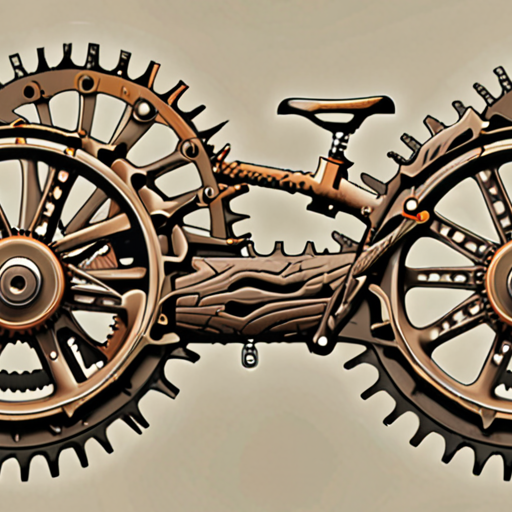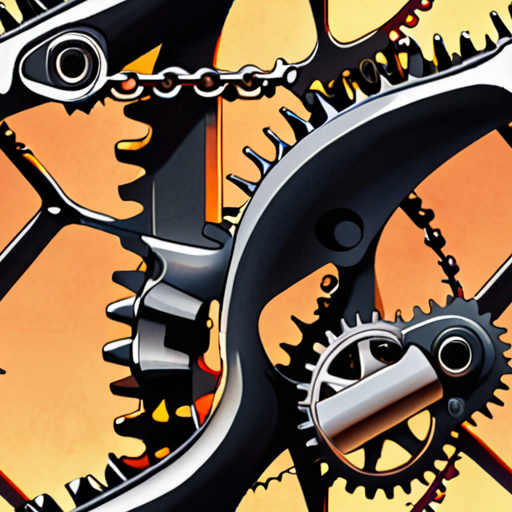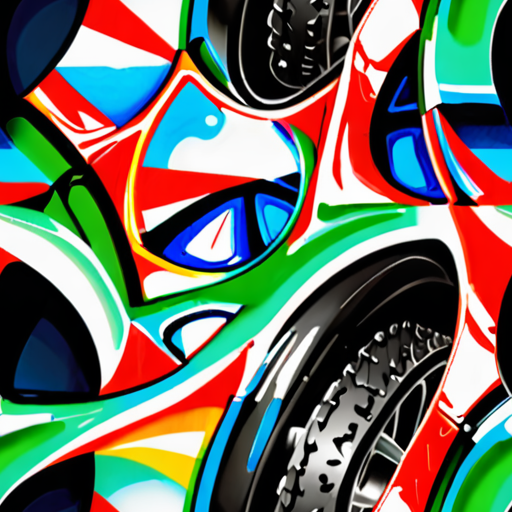Whether you’re a seasoned cyclist or just starting out, having the right bike parts and accessories can make all the difference in your riding experience. From the frame and fork to the wheels, tires, brakes, and gears, each component plays a crucial role in ensuring your safety, comfort, and performance on the road or trail. In this comprehensive guide, we’ll take a closer look at the essential bike components, explore the world of high-end bike frames and premium groupsets, and delve into the details of popular bike brands, gearing systems, and tire options.

Bike Components
We’re excited to share with you the essential components needed to assemble a complete bicycle.
- Forks and Frame
- Wheels and Tires
- Drivetrain
- Brakes
- Saddle and Seatpost
- Handlebars and Stem
- Gears and Shifters
- Accessories
The frame is the backbone of your bike, made from materials like steel, aluminum, or carbon fiber. Forks connect the front wheel to the frame, absorbing shock and vibrations.
Wheels come in various sizes and types, including clincher, tubular, and disc wheels. Tires provide traction, comfort, and durability, available in different widths and tread patterns.
The drivetrain consists of the crankset, chainrings, chain, cassette, and derailleur. These components work together to transmit power from the pedals to the rear wheel.
Braking systems can be mechanical or hydraulic, featuring calipers, levers, and rotors. They enable safe stopping and control on various terrain.
The saddle provides comfort and support for the rider, while the seatpost connects it to the frame.
Handlebars offer control and leverage, while the stem attaches them to the frame.
Gears allow riders to adjust difficulty and speed, while shifters facilitate smooth transitions between gears.
Additional components include water bottles, cages, pedals, and lights, which enhance the overall riding experience.
The Most Expensive Part of a Bicycle
The frame is often considered the most critical component of a bicycle, responsible for how the bike fits, rides, handles, and reacts.
- The frame is typically the most expensive part of a bicycle due to its complexity and the materials used in its construction.
- High-end frames can feature advanced materials such as carbon fiber, titanium, or high-strength steel, which contribute to their increased cost.
- Additionally, the design and manufacturing process of high-quality frames require significant expertise and investment, further driving up their price.
While other components, such as wheels, gears, and brakes, are essential to a bicycle’s functionality, they generally cost less than a high-end frame.
However, it’s worth noting that other factors, such as the type of bike, intended use, and brand reputation, can influence the overall cost of a bicycle.
For example, a high-performance road bike may have a more expensive frame than a commuter bike, but the latter may have additional features such as fenders, lights, and racks that increase its overall cost.
Ultimately, the most expensive part of a bicycle will depend on individual preferences and priorities, as well as the specific needs and requirements of the rider.
At Leeds Bicycle, we offer a wide range of bicycles to suit various budgets and riding styles, from entry-level models to high-performance road bikes.
Our knowledgeable staff would be happy to assist you in finding the perfect bike for your needs and budget.
Visit our website at https://leedsbicycle.com/ to learn more about our products and services.
We also recommend checking out other reputable brands in the industry, such as Trek Bikes and Specialized .
These brands offer high-quality bicycles that cater to various riding styles and preferences.
Remember to always prioritize your safety and comfort when choosing a bicycle, and don’t hesitate to reach out to us for expert advice and guidance.

The Big 3 Bike Brands
We’re often asked which bike brands dominate the market, and the answer is simple: Giant, Specialized, and Trek.
- Giant
- Specialized
- Trek
These three brands have been synonymous with high-quality bikes for decades, and for good reason. They offer a wide range of models to suit every type of rider, from casual commuters to professional athletes.
At Leeds Bicycle, we’ve worked with all three brands and can attest to their exceptional craftsmanship and attention to detail. Whether you’re looking for a sleek road bike or a rugged mountain bike, these brands have got you covered.
Let’s take a closer look at each of the big 3:
Giant
Giant is one of the largest bicycle manufacturers in the world, producing over 10 million bikes per year. Their extensive product lineup includes everything from entry-level commuter bikes to high-end racing machines.
Giant’s innovative designs and cutting-edge technology have made them a favorite among professional riders and enthusiasts alike. Their TCR Advanced series, for example, features advanced aerodynamics and lightweight materials that make it perfect for long-distance rides.
Specialized
Specialized is known for pushing the boundaries of what’s possible with bike design. Their innovative products, such as the S-Works Venge and Roubaix, feature advanced materials and technologies that set a new standard for speed and comfort.
From gravel grinders to downhill shredders, Specialized offers a wide range of bikes that cater to every type of riding style. Their commitment to innovation and customer satisfaction has earned them a loyal following among cyclists worldwide.
Trek
Trek is another iconic brand that’s been a staple in the cycling world for decades. Their extensive product lineup includes everything from family-friendly cruisers to high-performance road bikes.
Trek’s innovative designs and commitment to sustainability have made them a leader in the industry. Their Project One program, for example, allows customers to customize their own bikes with a wide range of colors and components.
Whether you’re a seasoned pro or just starting out, these three brands offer something for everyone. At Leeds Bicycle, we’re proud to partner with Giant, Specialized, and Trek to bring you the best bikes on the market.

Understanding the 7 Gears on a Bike
The 7-speed bike gears refer to the mechanical components that enable riders to adjust the difficulty level of pedaling.
- Gear Configuration
- A standard 7-speed bike features a single chainring at the front with a cassette of 7 cogs at the back.
- This setup allows for a moderate range of gears, making it suitable for casual riding and commuting.
- In contrast, a 21-speed bike typically has three chainrings at the front and a 7-cog cassette at the back.
- This configuration provides a wider range of gears, catering to more demanding rides and varied terrain.
When shifting between gears, the rider can adjust the difficulty level of pedaling to suit their needs.
- Why Use Multiple Gears?
- Multiple gears allow riders to conserve energy and maintain a comfortable pace.
- By switching to easier gears, riders can reduce fatigue and prevent strain on their muscles.
- Conversely, harder gears enable riders to tackle steeper inclines and increase their speed.
- This versatility makes bikes with multiple gears ideal for various riding styles and environments.
At Leeds Bicycle, we recommend experimenting with different gear configurations to find the perfect balance for your riding style.
For more information on bike maintenance and gear selection, visit our bike maintenance tips page.
Additionally, check out our cycling guides for expert advice on navigating various terrains and conditions.
Remember to always follow safety guidelines and best practices when riding your bike.
Stay safe and happy cycling!
Understanding the Gear System on Your Bike
The gear system on your bike is made up of several components, including the chainrings, cassette, derailleur, and shifters.
-
Chainrings:
Chainrings are the toothed wheels attached to the crankset of your bike. They determine the number of teeth engaged with the chain, which affects the difficulty of pedaling.
-
Single Chainring:
A single chainring has 22-24 teeth and provides a fixed gear ratio.
-
Double Chainring:
A double chainring has two chainrings with 22-24 teeth and 38-42 teeth, allowing for easier shifting between gears.
-
Triple Chainring:
A triple chainring has three chainrings with 22-24 teeth, 32-34 teeth, and 40-42 teeth, providing a wider range of gear ratios.
-
-
Cassette:
The cassette is the cluster of sprockets attached to the rear wheel hub. It contains 8-11 sprockets with varying numbers of teeth.
-
Sprocket Teeth:
The number of teeth on the sprockets determines the difficulty of pedaling. A lower number of teeth means easier pedaling, while a higher number means harder pedaling.
-
-
Derailleur:
The derailleur is a mechanism that moves the chain between the chainrings and cassette. It helps to adjust the tension of the chain and ensures smooth shifting.
-
Derailleur Types:
There are two types of derailleurs: mechanical and electronic. Mechanical derailleurs use cables and pulleys to shift gears, while electronic derailleurs use wireless signals to control the shifting process.
-
-
Shifters:
Shifters are the levers or buttons that control the movement of the derailleur. They allow you to change gears by pressing or pulling the lever.
-
Shifter Types:
There are two types of shifters: trigger shifters and grip shifters. Trigger shifters have a lever that you press to shift gears, while grip shifters have a button that you press to shift gears.
-
When looking at the gear system on your bike, you may see a notation like “123” on the shifter or derailleur. This notation refers to the combination of chainrings and sprockets available on your bike.
For example, if your bike has a triple chainring setup with 22-24 teeth, 32-34 teeth, and 40-42 teeth, and a cassette with 8-11 sprockets, the notation might look like this:
123 = Triple chainring setup with 22-24 teeth, 32-34 teeth, and 40-42 teeth, paired with a cassette containing 8-11 sprockets.
This notation helps you understand the gear ratios available on your bike and how to shift between them effectively.

Choosing Between 7 Gear and 21 Gear Cycles
The choice between a 7 gear and a 21 gear cycle ultimately depends on your cycling needs and preferences.
- A 7 gear cycle is ideal for flat terrains or casual riding, making it perfect for short commutes or leisurely rides.
- A 21 gear cycle, on the other hand, offers more flexibility and is better suited for varied terrains and challenging routes.
When deciding between these two options, consider the type of terrain you’ll be riding on most often.
- If you primarily ride on flat surfaces, a 7 gear cycle would be sufficient.
- However, if you plan to tackle hilly or mountainous terrain, a 21 gear cycle would provide the necessary gearing to handle the demands of the route.
Additionally, think about your personal comfort level and the type of riding you enjoy.
- If you prefer a more relaxed pace and don’t mind shifting gears frequently, a 7 gear cycle might be the better choice.
- On the other hand, if you’re looking for a challenge and want to push yourself physically, a 21 gear cycle could be the way to go.
Ultimately, the decision between a 7 gear and a 21 gear cycle comes down to your individual needs and preferences.
Key Considerations
Before making a final decision, take into account the following factors:
- Your budget: 7 gear cycles tend to be less expensive than 21 gear cycles.
- Your skill level: If you’re a beginner, a 7 gear cycle might be easier to manage.
- Your riding style: If you prefer a more aggressive riding position, a 21 gear cycle could be a better fit.
Conclusion
In conclusion, choosing between a 7 gear and a 21 gear cycle depends on your unique circumstances and preferences.
By considering your terrain, comfort level, and personal goals, you can make an informed decision that suits your needs and enhances your overall cycling experience.

0 Comments